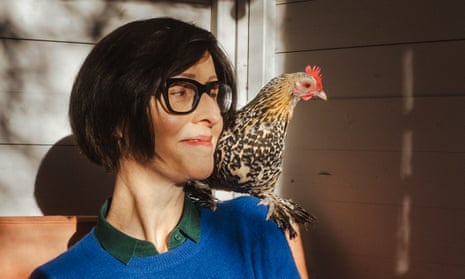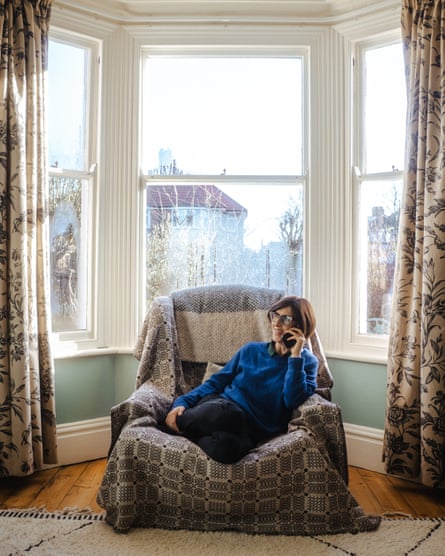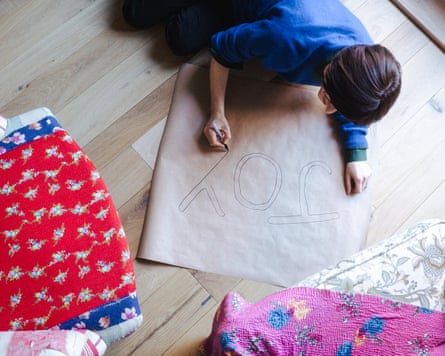- US edition
- UK edition
- Australia edition
- International edition
- Europe edition
- Wellness
- Fashion
- Food
- Recipes
- Love & sex
- Home & garden
- Health & fitness
- Family
- Travel
- Money

Can ‘micro-acts of joy’ make you happier? I tried them for seven days
I’m not naturally overflowing with contentment, and I’m not optimistic that this Californian programme is the answer – but I’m ready to give Big JOY a chance

I come across the words “Big JOY” while idly scrolling on my phone one morning and it stops me in my tracks. It’s the name: both funny and audacious (is an insidious joy industry manipulating us into bliss?). Who’s considering even medium-sized joy, when the horror of world events unfolds around us hourly?
But finding joy in hard times, personal or global, is precisely the point of Big JOY, a citizen science project based at the Greater Good Science Center at the University of California, Berkeley. Anyone can take part – it requires a time commitment of just seven minutes a day for seven days, with easy activities that studies suggest are likely to increase positive emotions. The premise is that we can work out what makes us feel good and do more of it. “Micro-acts of joy focus us on what is good about the life in front of us, and how we can make it better,” says Elissa Epel, a psychiatry professor at the University of California, San Francisco and author of The Seven-Day Stress Prescription, who is a collaborator on the Big JOY project. “This is critical during these dark times; these are ways we bring in the light.”
More than 88,000 people in 208 countries have tried Big JOY since it launched in November 2021 – and that number now includes me. I’m not naturally overflowing with joy; no one has ever mistaken me for a ray of sunshine. But I turn 50 this year and learning to squeeze more joy from life feels increasingly urgent. I’m not optimistic (obviously) that a week of “micro-acts” is the answer, but I’m ready to give Big JOY a chance.
Day 0: Getting started
Once I’ve signed up, my week kicks off with an exhortation to listen to a recording of people laughing. I don’t enjoy this: it feels overblown and fake like a sitcom laugh track. What the hell do you all have to laugh about (yes, even you, the baby at the end)? I also complete a questionnaire that goes alarmingly deep, asking me to assess whether I am “satisfied with my life as a whole”, whether I’ve felt “content with my relationships and friendships” this week and how much common humanity I feel with others. Yikes. I understand it’s about working out a baseline, though, and I’m excited for what’s to come.
Day 1: Celebrate another’s joy
A Big JOY email delivers my first challenge. Choose a person, or people, in my life and “plan to ask this person to tell you about something fun, wonderful or inspiring that they’ve experienced, or that has made them feel proud recently”. I try it at choir. Helen tells me about holding her brand-new first granddaughter in her arms in December; Cristina observed a goldcrest sitting on a bare branch; and Anna says she felt joy when we started singing a Welsh folk song. “There’s something quite special and rare about a group of people coming together to make music,” she reminds me.
It’s touching how openly and sincerely my choir mates engage with the exercise and I love hearing what has made them joyful. Big JOY suggests I nod, smile and say stuff like: “That must have felt great!” but I am not American, so I don’t; my smile is absolutely real though. Full disclosure: I also find myself telling a sad anecdote about a dead goldcrest, which absolutely no one needed to hear.

When prompted to do my late-night check-in – Big JOY asks you to rate your mood straight after the mission and again at the end of the day – I’m on a high. I rate this as something I’d like to do again and I do: I start asking my friends whenever I can. I learn about the fun and wonder they’ve got, variously, from singing to a cat, a fulfilling new job, “holiday sex with a Canadian oncologist” (“That must have felt great!” I consider and reject saying) and a Sesame Street documentary.
Day 2: You are a force of good
The demonstrably incorrect title of day 2 makes me frown when it appears in my inbox. Before I can explore further, however, I complete my morning check-in. The questions are the same morning and night: to what extent I’m feeling “pleasant emotions like delight, pride or hope” and then separately how much I’m feeling “unpleasant emotions like distress, sadness or anger”. It’s hard but interesting, splitting my emotions into positive and negative rather than just a muddy wash of anxiety-tinged blah-ness. “It’s helpful for our own self-knowledge and also for the scientific study that we become aware of all our feelings,” the Big JOY Q&A explains.
The task is to listen to a Buddhist prayer – apparently one of the Dalai Lama’s faves – reciting along if you wish. There is a sort-of spiritual context to Big JOY; the original idea came from Mission: Joy, a documentary featuring the Dalai Lama and Desmond Tutu, about finding joy in troubled times. The prayeris performed by Sah D’Simone, bestselling author of Spiritually Sassy, dance healer and guru for Channel 4’s Big Celebrity Detox. (Yes, I go down a deep Google hole on the amazing-sounding D’Simone to put off listening.)
I recite along although I’m deeply sceptical. The prayer suggests that “by virtue of my merits” amazing things will happen in the world, the blind will see, the poor find wealth and the thirsty find “delicious drinks”. It feels silly. But when I reach the last section about remaining to “dispel the miseries of the world”, I find myself crying. How can I be a “force of good”? I feel utterly powerless.
Day 3: Shift your perspective
Today I have to think of a time recently I felt “frustrated, anxious or upset” (it would be harder to think of a time I’m not), then “take a deep, slow breath” and write three positive things that came out of it. It takes me a while to settle on something: I can’t see an upside to being impersonated by online scammers, getting ringworm or becoming frighteningly incapacitated with anxiety over the summer, so I decide to focus on my dog’s death (at which point, I confess I’m questioning when the joy bit starts).
I take my deep breath and remember how close I felt to my husband as he cried next to me. I remember how writing about the experience connected me to people who had been through similar things. Then I think how often I still mention losing Oscar to strangers, months later. Just this week I had a surprisingly long and deep conversation in Waterstones with a woman and her sausage dog about grief (mainly the woman – the sausage dog was trying to eat a plush avocado). There’s something about the universality of loss that makes it a powerful force for connection, I suppose. Cheery.
Day 4: Make a gratitude list
Ah, this old chestnut. It’s on here for good reasons, I know. “Studies show that exercising gratitude can lead to more optimism about life, increased physical comfort and better health, quicker recovery from stressful and upsetting events, higher quantity and quality of friendships,” Big JOY explains. A meta-review of 70 studies of gratitude research in 2021 concluded that “individuals who experience more gratitude have lower levels of depression”. I have never tried, so I give it a sincere go.
I’m grateful for my home and the deep peace it affords me. I’m grateful for my affectionate and endlessly tolerant husband, a best friend who makes my life better every day, the opportunity to watch my sons become interesting adults and for the people I know who work in small ways to make the world around us better. Also my chickens. I’m really grateful for chickens. Thankfully I don’t have to rank which I’m most grateful for.
Day 5: Dwell in awe
Awe can make us feel more connected and compassionate and can increase feelings of physical and mental wellbeing. Unfortunately, as I tackle this nature-based awe exercise – watching a video of Yosemite – a worrying work issue crops up that sends me spiralling. The footage is very beautiful, but it barely registers with my heart thudding and palms sweating.
But dwelling in awe is one thing I know how to do, and it doesn’t happen in front of my laptop. I go into the garden and sit quietly on the ground. A robin comes very close to observe me; long-tailed tits flit around the feeders; the light is beautiful. Suburban York is no Yosemite; but it takes me out of my own exhausting head and gives me a fraction more perspective on my work problems.

Day 6: Tune in to what matters
Today I am supposed to rate values – virtue, fairness, goodwill and unity – and explain how they “inform and shape your day-to-day experiences”. At this point I start feeling slightly mutinous: I thought I was signing up for seven days of joy-inducing challenges (cuddle a baby, stroke a puppy, eat a cake, splash in a puddle, that sort of thing); instead I’m getting homework.
I dutifully rate my values and spend some time feeling bad at how little I actually embody them. It’s not sparking joy. “A micro-act of JOY that doesn’t result in JOY for you doesn’t mean anythingnegative about YOU, you wonderful human,” Big JOY says, reassuringly. As a reward for slogging through it, I go and do something that reliably brings me joy: playing with my hens.
When I do my mood check-ins, I’m struck at how often I find I am scoring myself above average on both positive and negative emotions, rather than all one way or the other. I’m always anxious, but on closer examination, I’m also contented. I think this gets to the kernel of what Big JOY is teaching: identifying or finding joy amid negative emotions and experiences.
Day 7: Do something kind
Doing something kind, my last challenge, feels manageable until I read the small print: I’m supposed to identify five separate people and a kind thing to do for them. Who am I, Amélie Poulain? I don’t even see five people most days.
On closer reading I don’t have to do all the acts immediately; just think about them. OK: I will darn my husband’s jumper that he keeps showing me, hopefully, and I keep ignoring. I will send a friend a care package, return a forgotten item to a colleague, give a compliment and drop some groceries at the food bank.
I make a start, and the to-do-list-ticking aspect of trotting off to the post office and food bank feels good. However I also shame myself for not having enough social contact to make this task easy, and not doing small kindnesses spontaneously more often.
The verdict
Following a final check-in, I unlock my “personalised joy report”. Cheeringly, my wellbeing has gone up 14.13%. Predictably for me, that’s lower than the average, based on the project’s interim findings, which showed an increase of 23%. “This was a much larger effect than we expected,” Epel says. “We found people increase in their positive emotions immediately and in feelings of flourishing by end of the week.”It wasn’t universal, however, she explains, and the next phase of the project will involve delving into the data to explore why. Participants are also volunteers, of course, so probably inclined to be receptive; there’s a further study in the works that will test how Big JOY works in controlled conditions.
The report also confirms what I felt: that what made me happiest were the tasks involving other people. Epel says her experience has been the same. “The prosocial interventions help me the most, and that’s no surprise ... happiness research suggests that kind acts for others are a powerful way to increase the subtle but lasting feelings of happiness.”
So have I embiggened my joy over seven days? Good question. Big JOY wasn’t the barrel of cartwheeling, kitten-kissing laughs I had hoped, but I think it’s given me something deeper: a reminder of how happy other people (not just hens) make me, especially if I can make them feel good too. The conclusion seems to be that to feel more joy, I need to become a more connected, outward-looking person, ruminate less and focus on finding ways, however small, of doing good in the world. Hmm. I have a funny feeling that was Big JOY’s dastardly plan all along.